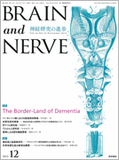Japanese
English
- 有料閲覧
- Abstract 文献概要
- 1ページ目 Look Inside
- 参考文献 Reference
Ⅰ.てんかん性高次脳機能障害
てんかんの症状として,高次脳機能障害が生じることが知られている。症状が持続性のものと一過性の発作で終わるものに2分されるが,両者をてんかん性高次脳機能障害(epilepsy with higher brain dysfunction:E-HBD)としてまとめることができる(Fig.1)。
持続性の高次脳機能障害を示すE-HBDのうち,非痙攣性てんかん重積(non-convulsive status epilepticus:NCSE)は,その名のとおりに明らかな痙攣を示さずにてんかん重積が起こっている状態である。NCSEの臨床型としてはさまざまな症候があるが,意識障害や凝視・反復性の瞬目/咀嚼/嚥下運動・自動症が一般的である。また,後述のように健忘1)や失語2)も,NCSEの症候として生じることが知られてきた。側頭葉てんかんに分類される焦点発作の重積によるNCSEでは,側頭葉の持つ機能である記憶や言語に障害が生じ,認知症に類似する臨床像を示す場合もある3)。
Abstract
Epilepsy with higher brain dysfunction (E-HBD) is sometimes associated with dementia. For example, temporal lobe epilepsy may cause amnesia or behavioral abnormality, and the patient resembles an Alzheimer disease or frontotemporal dementia.
E-HBD has two types, transient epileptic higher brain dysfunction and persistent. The persistent type is caused by non-convulsive status epileptics (NCSE), or "antiepileptic drug-responsive neurological deficit", and has no evidence of NCSE.
We present 3 cases of E-HBD, and suggest anti-epileptic drugs for patients with higher brain dysfunction.

Copyright © 2012, Igaku-Shoin Ltd. All rights reserved.


